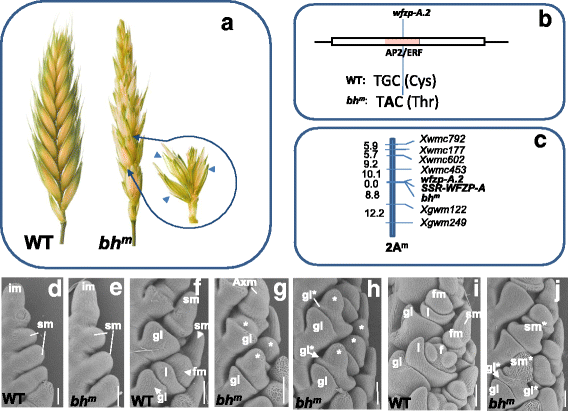Fig. 1

Spike branching in diploidT. monococcumwheat.a, Illustration of the spike structure in theT. monococcumKT 3–24 (middle), harboring short branch-like structures (right) with supernumerary spikelets (indicated with blue arrows) andT. sinskajaePI 418587 (a WT-spike) (left).b, Schematic representation of theWFZPgene structure and the mutation identified. The light red box indicates the AP2/ERF domain.c, A partial 2Ammolecular-generic map showing collocation ofbhm,wfzp-A.2and SSR-WFZP-A(ssrCS248B13–1 from Dobrovolskaya et al. [31]) on 2Am. Genetic distances are given in cM.d-j, Scanning electron microscopy images of KT 3–24 (bhm) and PI 418587 (WT) inflorescences at various developmental stages.dande, Spikelet differentiation stage in the wild type (d) andbhm(e). F, Early floret differentiation stages when the spikelet meristem produces the FM in the wild type.gandh, Differentiation of secondary AxMs (indicated by asterisks) in thebhmmutant.handj. The development of glumes (gl*) and FM*s by secondary AxMs in thebhmmutant.i, Floret differentiation stage showing differentiated floral organs in the WT-inflorescence.j, The development of ectopic spikelets inbhm. Bars = 100 μm.f, floret with floret organ primordia; fm, floret meristem; gl, glume; im, inflorescence meristem; l, lemma, sm, spikelet meristem; sm*, spikelet meristem of an ectopic spikelet
